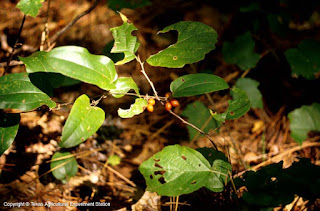Have you
ever just sat in your garden and looked at the world of the insects, bees,
reptiles, birds and the plants? I mean, get down on their level and see the world as they see it. My favorite thing to do is to take a cup of
coffee and go to the garden just as the sun comes up. The smell of the flowers
and herbs is almost overwhelming. Last week I sat and watched, for the longest time, an Anole and his
antics sparked my curiosity.
The Green
Anole (Anolis carolinensis) is indigenous to the southern
United States. With a dorsal coat of lime to emerald green (very rare and
gorgeous specimens are tinted blue), the green Anole is an agile climber and dines on spiders, grasshoppers and other insect prey. These green guys are personable little
lizards that seem to enjoy being hand-fed too. That is if you like picking up
spiders and grasshoppers.
These little herps (slang for reptiles and amphibians) are also sometimes referred to as the
American chameleon due to its ability to change color
from several brown hues to bright green. However, it is not a true chameleon. The color changes are caused by
hormones, background color or mood. Anoles also do push-ups to regulate their inner temperature. They are ectothermic which means their environment determines their body temperature. On a hot afternoon if you see a male Anole doing push-ups and there is no female around, chances are he is cooling off. Green Anoles tend to remain green
when temperatures are more than 70 degrees F., whereas they tend to remain
brown during cool weather conditions or when stressed. And get this - its toes have adhesive pads to facilitate
climbing.
This little green guy that I observed was doing push-ups all by himself. I was saddened. I’m sure you’ve seen them where you live.
Video courtesy of Courtney Neumeyer
This behavior is to catch the female Anole’s eye. Which leads to this.
Female lizards rate their guys by the size of their. . . .wait for it. . .dewlap. It is the bright-colored patch that the male lizard sports on their necks or on their bellies. Doing these push-ups is much like a body builder flexing his muscles.
So once in a while forget your gardening to do list and slow down, rest, relax and discover the soap opera that goes on daily in your garden. You may not get ahead of those weeds, but you will find unexpected drama unfolding. A leisurely pace has its rewards!





































